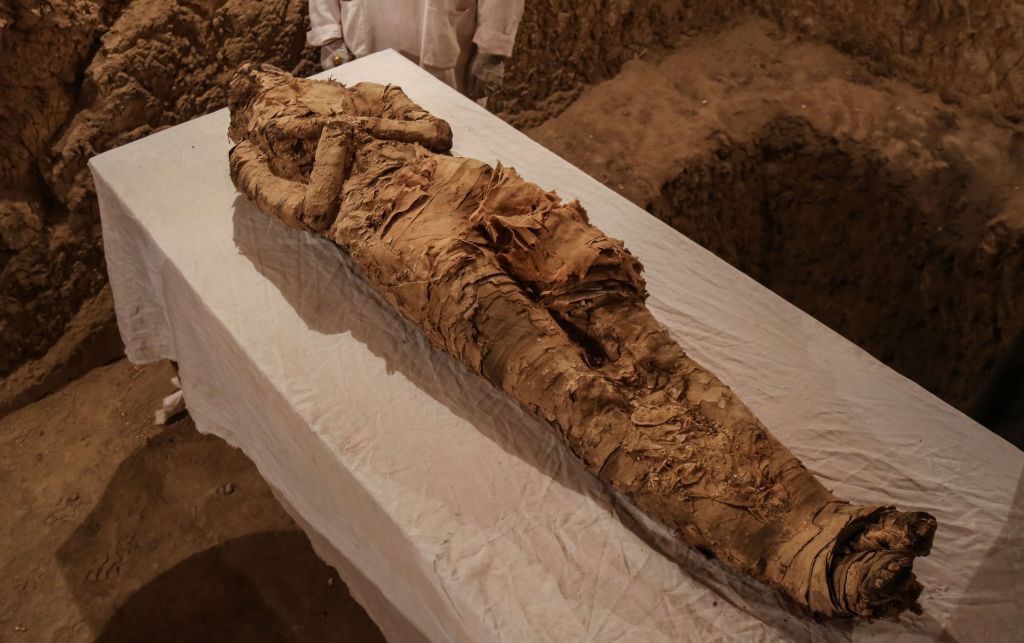Human and animal mummies have been studied intensively since Napoleon’s expedition to Egypt in 1798. Public unwrappings in mid-nineteenth century America sought to answer scientific questions about the ancient remains, as well as satisfy the curiosity of paid on-lookers. Mummies now yield their secrets in less invasive ways, informing Egyptologists about diseases, life span, and ancient nutrition. As one of the ultimate symbols of ancient Egypt, the mummy continues to inhabit our own culture through many media–especially movies.

In 1894, Nancy Fish Barnum, widow of the famous circus owner, acquired this mummy in Egypt and presented it with the coffin to the Bridgeport Scientific Society and Fairfield County Historical Society. The mummy and the coffin were not originally a “set,” but rather had been put together for sale in modern times. The coffin once belonged to a man named Pa-ib (for more information see the Coffin of Pa-Ib), while the mummy is that of a woman approximately thirty years old. The mummy was unwrapped in August 1894, during which the audience remarked on the “thousands of yards of linen bandages” that were unwrapped from a body that had a “peculiar and slightly disagreeable odor.”
George Gliddon and the Great Mummy Unwrappings of 1850 and 1851
On December 14, 1824, the first public unwrapping of a mummy in America was performed before a small audience of medical and scientific gentlemen at New York City’s Castle Garden. The mummy which was unwrapped had been brought by Captain Larkin Thorndike Lee, and its disrobing was engineered in order to satisfy scientific curiosity as well as to ascertain the authenticity of the artifact. The mummy was pronounced to be genuine and female. and a description of it was given in the newspaper accounts of the unwrapping.The next unwrapping of note was held at Rubens Peale’s New York museum in 1826. Two mummies which Peale had recently purchased were to be unwrapped before the public (although no children would be admitted, perhaps expecting the subject to be too unsettling for young minds.) on the afternoon of March 3. After this, the mummies would lie in state at the museum for the satisfaction of the curious. Mummies were a prime draw for the public—wherever they were exhibited, people came by the hundreds to view the ancient relics. Almost always, the mummies were advertised as being royal, female, and even on occasion as the princess who saved Moses from the bulrushes.

A few other unwrappings followed this one, but none were as memorable as those performed by George Gliddon in 1850 and 1851. George Robbins Gliddon was born in Devonshire, England in 1809, the son of John G. Gliddon, who later became U.S. Consul at Alexandria. He was taken to Egypt at an early age, and later even became U.S. Vice-Consul staioned in Egypt at Cairo himself. In 1842, Gliddon came to America, where he lectured on Egyptian archaeology in Boston and in Lowell, Massachusetts, and as far west as St. Louis. He also published several works about ancient Egypt: Otia Aegyptiaca, An Appeal To the Antiquaries of Europe On the Destruction of the Monuments of Egypt, and Ancient Egypt, Her Monuments, Hieroglyphics, History and Archaeology, and Other Subjects Connected with Hieroglyphical Literature.
Both Gliddon and his father had been active in procuring mummy skulls for Samuel George Morton, who was collecting the grisly reremains to bolster his theories on polygenesis—the idea that the races of man had sprung from different progenitors. One of the key arguments was that different races had different brain capacities, hence his great interest in skulls. The idea was highly racially charged and an unacknowledged goal of these mummy unwrappings was to prove that the Egyptians were not of “the black race.” The dark hue of the bodies was always explained to be the result of embalming techniques, and mention was always made of the delicate features and light-colored hair, whose consistency was described as smooth, not “crinkly” or “wooly”. Gliddon himself was a sincere follower of Morton’s theses; together with Josiah Nott, he would later publish his own version of these studies in Types of Mankind, Or, Ethnological Researches Based Upon the Ancient Monuments, Paintings, Sculptures, and Crania of Races; And Upon Their Natural, Geographical, Philological and Biblical History. This book was considered to be so hugely derogatory in regards to the black component of humanity, that it is still castigated as being virulently racist.
While in England in 1849, Gliddon purchased the Panorama of the Nile, a “transparent” moving painting of the entire great river and its attractions and brought it to America for exhibition. In order to drum uo interest in this great moving depiction of Egypt and its monuments, Gliddon also proposed to unwrap some mummies that he had obtained with great difficulty and expense. According to note